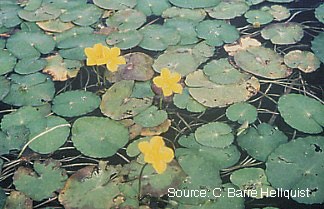Community News

Yellow Floating Heart
Description: Rounded to heart-shaped floating leaves rise on long stalks from rooted stems. Each rooted stem supports a loosely branched group of several leaves. Note that all heart-shaped floating leaved plants that are native to Maine produce only one leaf per rooted stem. The leaves are typically wavy (shallowly scalloped) along the outer edges and have purplish undersides.
Habitat: Yellow floating heart is found within the floating-leaved plant community. It can grow in various substrates (sand, mud, gravel, etc.), in littoral areas ranging from the damp mud along the water’s edge to water depths of 4 meters.
Annual Cycle: Yellow floating heart is an aquatic perennial that grows by seeds, broken pieces, and spreading creeping underground stems. Most floating leaved plants lack the ability to grow by broken pieces, but in the case of yellow floating heartbroken leaves with attached stem parts will form new plants. Viable seeds are produced abundantly and sprout readily. Seed hairs help the seeds float and aid their attachment to waterfowl, increasing possibility of spread to new areas.
Origin and U.S. Range: Yellow floating heart is native to parts of Europe and Asia. It is not native to North America and was introduced to this country as an ornamental pond species. Nearby populations occur in Massachusetts, Vermont, Connecticut and New York.
Look a likes: May be confused with European frog-bit, fragrant water-lily, little floating heart, spatterdock, and watershield.
